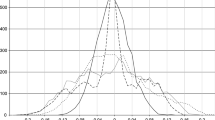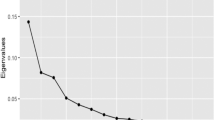Abstract
We generalize factor analysis models by allowing the concentration matrix of the residuals to have nonzero off-diagonal elements. The resulting model is named graphical factor analysis model. Allowing a structure of associations gives information about the correlation left unexplained by the unobserved variables, which can be used both in the confirmatory and exploratory context. We first present a sufficient condition for global identifiability of this class of models with a generic number of factors, thereby extending the results in Stanghellini (1997) and Vicard (2000). We then consider the issue of model comparison and show that fast local computations are possible for this purpose, if the conditional independence graphs on the residuals are restricted to be decomposable and a Bayesian approach is adopted. To achieve this aim, we propose a new reversible jump MCMC method to approximate the posterior probabilities of the considered models. We then study the evolution of political democracy in 75 developing countries based on eight measures of democracy in two different years.
Similar content being viewed by others
References
Bartholomew, D.J. (1994). Bayes' theorem in latent variable modelling. In P.R. Freeman & A.F.M. Smith (Eds.),Aspects of uncertainty: A tribute to D.V. Lindley (pp. 41–50). New York, NY: Wiley.
Bollen, K.A. (1989).Structural equations with latent variables. New York, NY: Wiley.
Bozdogan, H., & Shigemasu, K. (1998). Bayesian factor analysis model and choosing the number of factors using a new informational complexity criterion. In A. Rizzi, M. Vichi, & H. Bock (Eds.),Advances in data science and classification (pp. 335–342). Berlin, Germany: Springer.
Browne, M.W. (1980). Factor analysis of multiple batteries by maximum likelihood.British Journal of Mathematical and Statistical Psychology, 33, 184–199.
Cox, D.R., & Wermuth, N. (1993). Linear dependencies represented by chain graphs.Statistical Science, 8, 204–283.
Cox, D.R., & Wermuth, N. (1994). Tests for linearity, multivariate normality and the adequacy of linear scores.Applied Statistics, 43, 347–335.
Cox, D.R., & Wermuth, N. (1996).Multivariate dependencies. Models analysis and interpretation. London, U.K.: Chapman and Hall.
Cox, D.R., & Wermuth, N. (2000).A sweep operator for triangular matrices and its statistical applications (ZUMA Research Rep. 00-04). Mannheim, Germany: Centre for Survey Research and Methodology.
Dawid, A.P., & Lauritzen, S.L. (1993). Hyper Markow Laws in the statistical analysis of decomposable graphical models.Annals of Statistics, 21, 1272–1317.
Edwards, D. (1995).Introduction to graphical modelling. New York, NY: Springer-Verlag.
Edwards, D. (2000).Introduction to graphical modelling (2nd ed.). New York, NY: Springer-Verlag.
Frydenberg, M., & Lauritzen, S.L. (1989). Decomposition of maximum likelihood in mixed graphical interaction models.Biometrika, 76, 539–555.
Giudici, P., & Green, P.J. (1999). Markov Chain Monte Carlo Bayesian decomposable graphical Gaussian model determination.Biometrika, 84, 785–801.
Green, P.J. (1995). Reversible jump Markov chain Monte Carlo computation and Bayesian model determination.Biometrika, 82, 711–732.
Lauritzen, S.L. (1996).Graphical models. Oxford, England: Oxford University Press.
Lopes H., & West, M. (1998).Model uncertainty in factor analysis (ISDS Discussion Paper 98-38). Durham, NC: Duke University, Institute of Statistics and Decision Sciences.
Pearl, J. (1998). Graphs, causality and structural equation models.Sociological Methods and Research, 27, 226–284.
Press, S.J. & Shigemasu, K. (1989). Bayesian Inference in Factor Analysis. In L.J. Gleser, M.D. Perlman, S.J. Press, & A.R. Sampson (Eds.),Contributions to probability and statistics: Essays in honour of Ingram Olkin (271–287). New York, NY: Springer Verlag.
Richardson, S., & Green, P.J. (1997). On Bayesian analysis of mixtures with an unknown number of components.Journal of the Royal Statistical Society, Series B, 59, 731–758.
Stanghellini, E. (1997). Identification of a single-factor model using graphical Gaussian rules.Biometrika, 84, 241–244.
Vicard, P. (2000). On the identification of a single-factor model with correlated residuals.Biometrika, 87, 199–205.
Wright, S. (1923). The Theory of path coefficients: a reply to Niles' criticism.Genetics, 8, 239–255.
Wright, S. (1934). The method of path coefficients.Annals of Statistics, 5, 161–215.
Author information
Authors and Affiliations
Corresponding author
Additional information
We acknowledge support from M.U.R.S.T. of Italy and from the European Science Foundation H.S.S.S. Network. We are grateful to the referees and the Editor for many useful suggestions and comments which led to a substantial improvement of the paper. We also thank Nanny Wermuth for stimulating discussions and Kenneth A. Bollen for kindly providing us with the data-set.
Rights and permissions
About this article
Cite this article
Giudici, P., Stanghellini, E. Bayesian inference for graphical factor analysis models. Psychometrika 66, 577–591 (2001). https://doi.org/10.1007/BF02296197
Received:
Revised:
Issue Date:
DOI: https://doi.org/10.1007/BF02296197




